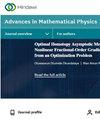用谱法分析径向可拉伸旋转盘引起的磁流体动力学微极纳米流体流动
IF 1.1
4区 物理与天体物理
Q3 PHYSICS, MATHEMATICAL
引用次数: 0
摘要
本分析旨在利用Cattaneo-Christov非傅立叶热和非Fick质量通量模型研究MHD微极纳米流体通过径向可拉伸旋转圆盘的流动。首先,该模型以动量、微旋转、热和浓度的非线性偏微分方程(PDE)及其边界条件的形式发展。采用适当的相似变换,将控制这些偏微分方程的边界层微极纳米流体流转化为无量纲耦合非线性常微分方程(ODEs)的大系统。利用谱局部线性化方法对这些无量纲常微分方程进行了数值求解。深入检查了更明显的相关参数对不同流场和感兴趣的工程量的影响,并通过图表和表格给出了结果。所获得的结果证实了SLLM是求解大型耦合方程组的一种稳定、准确、收敛且计算效率很高的方法。随着径向拉伸参数值的提高,径向速度增大,切向速度、温度和浓度分布减小,因此,在实际应用中,圆盘的径向拉伸有助于推进旋转圆盘的冷却过程。微旋转参数(A1−A6)中微旋转粘度的出现降低了径向速度分布,并且流体的动能在远离圆盘表面的情况下在一定程度上降低。该研究的新颖之处在于考虑了微极流体元素产生的微观效应,如微运动和耦合应力,非傅立叶热和非菲克质量通量的影响,以及径向拉伸圆盘对微极纳米流体流动、热和质量传递的影响。本文章由计算机程序翻译,如有差异,请以英文原文为准。
Analysis of Magnetohydrodynamic Micropolar Nanofluid Flow due to Radially Stretchable Rotating Disk Employing Spectral Method
The present analysis is aimed at examining MHD micropolar nanofluid flow past a radially stretchable rotating disk with the Cattaneo-Christov non-Fourier heat and non-Fick mass flux model. To begin with, the model is developed in the form of nonlinear partial differential equations (PDEs) for momentum, microrotation, thermal, and concentration with their boundary conditions. Employing suitable similarity transformation, the boundary layer micropolar nanofluid flows governing these PDEs are transformed into large systems of dimensionless coupled nonlinear ordinary differential equations (ODEs). These dimensionless ODEs are solved numerically by means of the spectral local linearization method (SLLM). The consequences of more noticeable involved parameters on different flow fields and engineering quantities of interest are thoroughly inspected, and the results are presented via graph plots and tables. The obtained results confirm that SLLM is a stable, accurate, convergent, and computationally very efficient method to solve a large coupled system of equations. The radial velocity grows while the tangential velocity, temperature, and concentration distributions turn down as the value of the radial stretching parameter improves, and hence, in practical applications, radial stretching of the disk is helpful to advance the cooling process of the rotating disk. The occurrence of microrotation viscosity in microrotation parameters (
A
1
−
A
6
) declines the radial velocity profile, and the kinetic energy of the fluid is reduced to some extent far away from the surface of the disk. The novelty of the study is the consideration of microscopic effects occurring from the micropolar fluid elements such as micromotion and couple stress, the effects of non-Fourier’s heat and non-Fick’s mass flux, and the effect of radial stretching disk on micropolar nanofluid flow, heat, and mass transfer.
求助全文
通过发布文献求助,成功后即可免费获取论文全文。
去求助
来源期刊

Advances in Mathematical Physics
数学-应用数学
CiteScore
2.40
自引率
8.30%
发文量
151
审稿时长
>12 weeks
期刊介绍:
Advances in Mathematical Physics publishes papers that seek to understand mathematical basis of physical phenomena, and solve problems in physics via mathematical approaches. The journal welcomes submissions from mathematical physicists, theoretical physicists, and mathematicians alike.
As well as original research, Advances in Mathematical Physics also publishes focused review articles that examine the state of the art, identify emerging trends, and suggest future directions for developing fields.
 求助内容:
求助内容: 应助结果提醒方式:
应助结果提醒方式:


